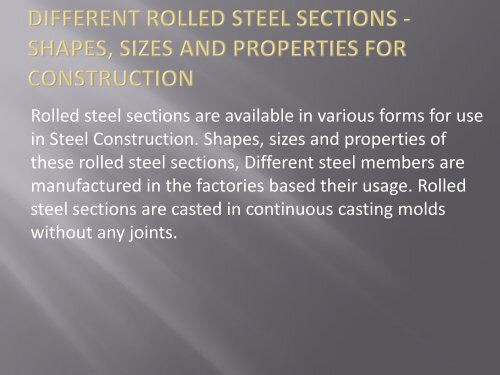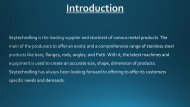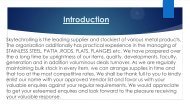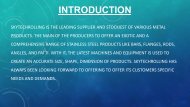Different Rolled Steel Bars and Sections
You also want an ePaper? Increase the reach of your titles
YUMPU automatically turns print PDFs into web optimized ePapers that Google loves.
<strong>Rolled</strong> steel sections are available in various forms for use<br />
in <strong>Steel</strong> Construction. Shapes, sizes <strong>and</strong> properties of<br />
these rolled steel sections, <strong>Different</strong> steel members are<br />
manufactured in the factories based their usage. <strong>Rolled</strong><br />
steel sections are casted in continuous casting molds<br />
without any joints.
‣Angle sections<br />
‣Channel sections<br />
‣T- sections<br />
‣Round bars<br />
‣Square bars<br />
‣Flat bars<br />
‣Corrugated sheets<br />
‣Plates<br />
‣Thermo-mechanically treated bars
Angle sections are manufactured in “L” shape. It contains<br />
two legs. Some angle sections contains legs with similar<br />
dimensions are called as equal angle sections <strong>and</strong> some<br />
contains different legs are called as unequal angle sections.<br />
Angle sections are widely used for roof truss constructions<br />
<strong>and</strong> for filler joist floors.
The channel section or C- section consists two equal flanges<br />
connected to web at both ends. Channel sections are<br />
extensively used in steel framed structures.<br />
They are available in various sizes ranging from 100 mm x 45<br />
mm to 400 mm x 100 mm. Corresponding unit weights are<br />
58 N <strong>and</strong> 494 N per meter length respectively.
T section consists of flange <strong>and</strong> web arranged in “T” shape.<br />
They are used in steel roof trusses to form built up sections.<br />
Two angle sections can also be joined to get T section.<br />
<strong>Rolled</strong> T sections size varies from 20 mm x 20 mm x 3 mm to<br />
150 mm x 150 mm x 10 mm with 9 N <strong>and</strong> 228 N as their<br />
corresponding weights per meter length.
Round bars contain circular cross sections <strong>and</strong> these are<br />
used as reinforcement in concrete <strong>and</strong> steel grill work etc.<br />
Stainless <strong>Steel</strong> Round bars are available in various diameters<br />
varies from 5 mm to 250 mm.
Square bars contain square cross sections <strong>and</strong> these are<br />
widely used for gates, windows, grill works etc. the sides of<br />
square cross section ranges from 5 mm to 250 mm. They<br />
are available in various materials <strong>and</strong> grades like stainless<br />
steel square bars, carbon steel, alloys steel etc.
Flat bars are also used for gates, windows, grill works etc.<br />
Stainless <strong>Steel</strong> Flat bars are designated with width of the bar<br />
which varies from 10 mm to 400 mm. thickness of flat bars<br />
will be from 3 mm to 40 mm.
Plain steel sheets are passed through machines which<br />
produce bends by pressing them called corrugations. These<br />
sheets are used for roof coverings.
<strong>Steel</strong> plates are well used items in steel structures. They are<br />
used for connecting steel beams, tensional member in roof<br />
truss etc. They are designated with their thickness which is<br />
varying from 5 mm to 50 mm.
Thermo-mechanically treated bars or TMT bars are<br />
manufactured by a special technique in which the red-hot<br />
steel bars are suddenly quenched by spraying water on it.<br />
So, surface of bar gets cooled down <strong>and</strong> inner side or core<br />
of the bar still in hot condition.<br />
The core helps the outer surface to be tempered. By this<br />
combination of different temperature, the bar gains more<br />
yield strength <strong>and</strong> exhibits good elongation at ultimate<br />
failure.<br />
Copper, phosphorous <strong>and</strong> chromium etc. are added in<br />
manufacturing process of TMT bars which improves its<br />
corrosion resistance.







